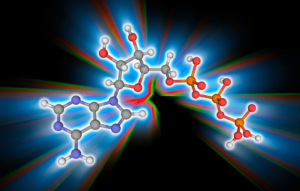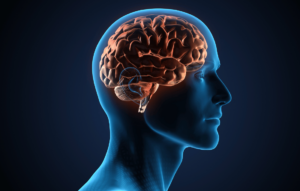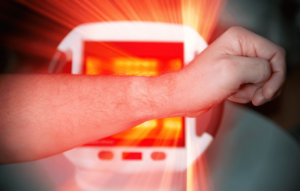The field of health and wellness is constantly evolving. New technologies and therapies capture the spotlight for a moment, then fade or remain as people discern whether or not they’re worth the hype. Among the emerging trends, red light therapy has grown in popularity and remained standing as a promising modality with a growing body of research supporting its benefits. From professional athletes seeking peak performance to regular people looking to optimize their overall well-being, red light therapy has gained a lot of attention for its potential to enhance many aspects of health.
In this blog, we’ll illuminate (haha) the realm of red light therapy and its specific implications for men’s health. As men navigate the complexities of maintaining optimal physical and mental well-being, understanding the benefits of innovative approaches like red light therapy can provide valuable insights and opportunities for improvement.
We’ll explore the science behind red light therapy, uncover its potential benefits for men, and discuss practical ways to incorporate it into daily routines. Whether you’re an athlete aiming to recover faster, a professional striving for peak cognitive performance, or simply someone striving to be at your best, come along with us on this exploration into red light therapy and see if it’s worth integrating into your own routine.
What Is Red Light Therapy?
Red light therapy, also known as photobiomodulation or low-level laser therapy, harnesses the healing power of specific wavelengths of light to stimulate cellular activity. Unlike the potentially harmful ultraviolet rays of sunlight, red light therapy uses non-invasive, low-energy light-emitting diodes (LEDs) to penetrate the skin’s surface without causing any damage.
At the cellular level, red and near-infrared wavelengths of light are absorbed by mitochondria, the powerhouse of cells, leading to an increase in adenosine triphosphate (ATP) production. This boost in ATP synthesis enhances cellular metabolism, promoting various healing processes within the body.
Devices used for red light therapy come in different forms, including panels, beds, and handheld devices, allowing for targeted treatment of specific areas or whole-body exposure. While red light therapy is generally considered safe, you should still take caution to follow manufacturer guidelines and consult with a healthcare professional if you have questions, especially for individuals with certain medical conditions or skin sensitivities.
The Science Behind Red Light Therapy
The efficacy of red light therapy is grounded in a pretty robust body of scientific research that points to its ability to modulate cellular functions and promote tissue repair. Studies have shown that the red and near-infrared light wavelengths penetrate the skin to reach target tissues, where they interact with chromophores, such as cytochrome C oxidase, initiating a cascade of cellular responses.
One of the primary effects of red light therapy is the stimulation of mitochondrial activity. By increasing ATP production, red light therapy enhances cellular energy metabolism, facilitating various physiological processes crucial for health and vitality. This heightened cellular activity promotes tissue repair, reduces inflammation, and enhances circulation, contributing to improved overall well-being.
Furthermore, red light therapy has been shown to promote collagen synthesis and fibroblast proliferation, leading to enhanced skin health and wound healing. The stimulation of collagen production can help reduce the appearance of wrinkles and fine lines, making it a popular choice for people seeking non-invasive anti-aging solutions.
The specific wavelengths used in red light therapy, typically in the range of 600 to 850 nanometers, have been carefully selected based on their ability to penetrate the skin and target deeper tissues. Near-infrared wavelengths, in particular, have demonstrated significant benefits for promoting tissue repair and reducing inflammation, making them particularly valuable for therapeutic applications.
Physical Health Benefits of Red Light Therapy
Red light therapy offers a myriad of benefits to address various aspects of men’s health, making it a versatile tool for optimizing well-being.
Improved Testosterone Production and Hormonal Balance
Research suggests that red light therapy, particularly when applied to the testes, can positively influence testosterone production and hormonal balance in men. By stimulating Leydig cells in the testes, red light therapy can enhance testosterone synthesis, which plays a crucial role in maintaining muscle mass, bone density, and overall vitality. For men experiencing age-related declines in testosterone levels or seeking to optimize hormonal balance, red light therapy offers a non-invasive intervention with promising results.
stimulating Leydig cells in the testes, red light therapy can enhance testosterone synthesis, which plays a crucial role in maintaining muscle mass, bone density, and overall vitality. For men experiencing age-related declines in testosterone levels or seeking to optimize hormonal balance, red light therapy offers a non-invasive intervention with promising results.
Enhanced Muscle Recovery and Athletic Performance
Athletes and fitness enthusiasts can benefit from red light therapy’s ability to accelerate muscle recovery and enhance athletic performance. By promoting cellular repair and reducing inflammation, red light therapy helps alleviate muscle soreness and fatigue following intense workouts or physical activity. This expedited recovery process allows athletes to train more effectively and achieve peak performance levels.
Reduction of Inflammation and Pain Relief
Chronic inflammation and pain can significantly impact men’s quality of life, whether due to sports injuries, arthritis, or other underlying conditions. Red light therapy has demonstrated anti-inflammatory properties, helping to mitigate inflammation and alleviate pain associated with various musculoskeletal issues. By targeting inflammatory pathways at the cellular level, red light therapy offers a non-pharmacological approach to pain management, reducing reliance on traditional analgesics and their potential side effects.
Promotion of Hair Growth and Prevention of Hair Loss
Hair loss is a common concern for many men, impacting self-esteem and confidence. Red light therapy has shown promise in promoting hair growth and preventing further hair loss by stimulating follicular activity and increasing blood flow to the scalp. Clinical studies have highlighted the efficacy of red light therapy as a non-invasive treatment option for male pattern baldness and other forms of hair loss, offering hope to men seeking to preserve their hairline and achieve thicker, healthier hair.
Benefits for Skin Health and Anti-Aging
In addition to its therapeutic effects on muscles and tissues, red light therapy offers notable benefits for skin health and anti-aging. By stimulating collagen production and improving skin elasticity, red light therapy helps reduce the appearance of wrinkles, fine lines, and age spots, promoting a more youthful complexion. Men looking to maintain healthy, vibrant skin can incorporate red light therapy into their skincare routines to complement existing skincare practices and combat the signs of aging effectively.

As we can see, the multifaceted benefits of red light therapy make it a powerful tool for supporting men’s health and well-being across many domains, from physical performance and recovery to aesthetic enhancement and anti-aging skincare.
Red Light Therapy and Mental Health
While red light therapy is often associated with physical benefits, its effects also extend to mental health and emotional well-being, offering men additional avenues for holistic self-care. Research indicates that red light therapy can positively impact mood regulation, cognitive function, and sleep quality, making it a valuable tool for managing stress and promoting mental resilience.
Mood Regulation and Emotional Well-Being
Red light therapy has been shown to influence neurotransmitter activity and brain function, potentially modulating mood states and emotional responses. By stimulating the production of serotonin, often referred to as the “feel-good” neurotransmitter, red light therapy may help alleviate symptoms of depression and anxiety, promoting a sense of well-being and emotional stability. Men facing the challenges of modern life, including work-related stress and societal expectations, can get some significant feel-good benefits from integrating red light therapy into their self-care routine.
Cognitive Performance and Mental Clarity
The cognitive benefits of red light therapy extend to enhanced mental clarity, focus, and cognitive function. By increasing cerebral blood flow and oxygenation, red light therapy may support optimal brain health and cognitive performance, sharpening mental acuity and concentration. Whether navigating demanding work projects, or trying to mitigate brain injuries (even subconcussive brain injuries accumulated over time), men can leverage the cognitive-enhancing effects of red light therapy to maintain peak mental performance and productivity.
Sleep Quality and Circadian Rhythm Regulation
Adequate sleep is essential for overall health and vitality, yet many men struggle with sleep disturbances and insomnia. Red light therapy has been shown to modulate circadian rhythms and promote restful sleep by regulating melatonin production and improving sleep architecture. By incorporating red light therapy into their evening routines, men can establish healthy sleep patterns and enhance the quality and duration of their rest, facilitating physical recovery and mental rejuvenation.
By addressing the interconnectedness of physical and mental health, red light therapy can help you take a proactive approach to self-care, fostering holistic well-being and overall resilience.
Incorporating Red Light Therapy into Your Routine
Now that we’ve explored the wide range of benefits of red light therapy, let’s discuss practical strategies for incorporating it into your daily routine. Here are some pro tips:
- Choose the Right Device: Selecting the proper device is crucial for achieving optimal results. Consider factors such as treatment area, wavelength specificity, and device features when choosing between panels, handheld devices, or full-body beds. Look for devices with clinically proven wavelengths in the red and near-infrared spectrum (typically 600 to 850 nanometers) and reputable manufacturers with a track record of quality and safety.
- Establish a Consistent Routine: Consistency is key when it comes to red light therapy. Plan regular sessions into your daily or weekly schedule to maximize the cumulative benefits over time. Depending on your goals and preferences, you may choose to use red light therapy in the morning to boost energy and focus, before workouts to enhance performance and recovery, or in the evening to promote relaxation and sleep.
- Follow Recommended Guidelines: Follow the rules! Always follow recommended guidelines for duration, intensity, and distance from the device to make sure you’re being both safe and effective. Start with shorter sessions and gradually increase exposure time as tolerated. Pay attention to any contraindications or precautions, particularly if you have underlying medical conditions or are taking medications that may affect photosensitivity.
- Integrate Red Light Therapy with Other Practices: Red light therapy can complement other health and wellness practices, such as exercise, nutrition, and mindfulness meditation. Consider incorporating red light therapy into your pre- or post-workout routine to optimize recovery and muscle performance. Pairing red light therapy with nutrient-rich foods and supplements can enhance cellular repair and regeneration while combining it with relaxation techniques can amplify its stress-reducing benefits.
- Track Your Progress and Adjust as Needed: Keep track of your experiences and outcomes with red light therapy, noting any changes in physical performance, mood, or overall well-being. Take note of key metrics such as muscle soreness, sleep quality, and cognitive function to gauge the effectiveness of your red light therapy regimen. Be open to adjusting your approach based on individual responses and evolving goals, and, as always, seek guidance from healthcare professionals as needed.
By integrating red light therapy into your daily routine with intention and consistency, you can unlock its full potential to optimize your health and well-being across multiple dimensions. Experiment with different strategies and find what works best for you.

Conclusion
In conclusion, red light therapy has emerged as a promising technology for optimizing health and well-being, particularly for men looking to gain an extra edge. It offers us a non-invasive and versatile approach to addressing a wide range of concerns. Through its ability to stimulate cellular activity, promote tissue repair, and modulate physiological processes, red light therapy provides tangible benefits across physical, mental, and emotional domains.
The effects on testosterone production and accelerating muscle recovery are significant and can absolutely help guys perform, in many areas, at their best. By integrating red light therapy into your daily routine, with consistency and intention, you can unlock your full potential to enhance vitality, resilience, and overall quality of life.
As we continue to develop our understanding of the benefits of red light therapy and its practical applications, it’s evident that this innovative technology holds great promise for individuals seeking non-pharmacological solutions to optimize their health and well-being. Whether you’re an athlete striving for peak performance, a professional balancing the demands of work and family, or simply someone committed to living your best life, consider harnessing the power of red light therapy as part of your wellness toolkit.








